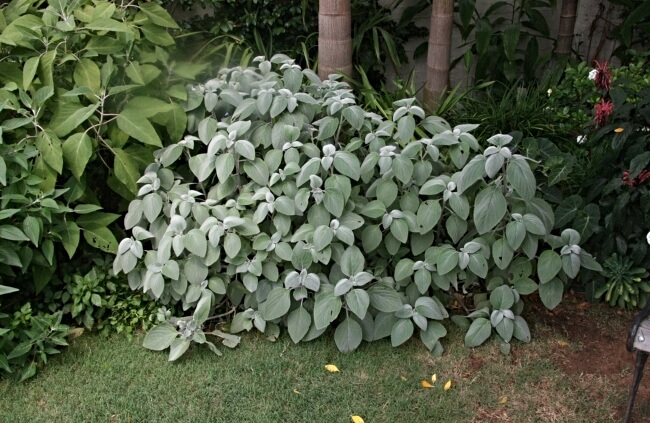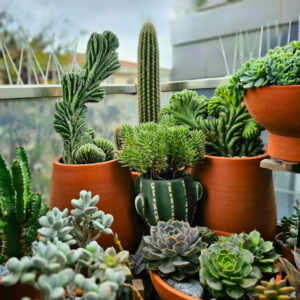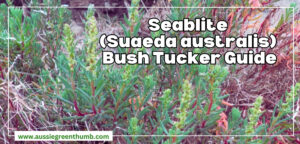There’s no better way to add a burst of colour to your garden than by growing some of the many incredible, endemic flowering species we have in Australia. Perfectly adapted to grow in our climate and soils, Australian Native Flowers are incredibly advantageous, and beneficial for our wildlife, not to mention beautiful in their own right.
More...
If you’re considering turning your garden into a naturalistic paradise or you’re looking for a native feature plant, then this guide is for you.
Australia is filled with some of the most unique flora and fauna on the globe. So, if you’re looking for inspiration for Australian flowers to grow in your garden, you’re certainly not short on options.
There are an incredible array of endemic species that can add a burst of colour, life and exciting new ecology to your garden year-round.
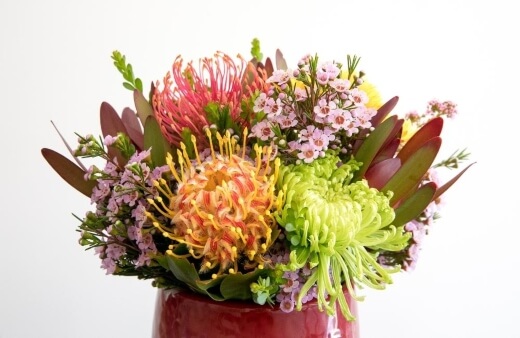
42 Best Australian Native Flowers to Grow
Choosing native flowers in Australia is a great choice for local growers. Not only is it sustainable and supportive of local ecosystems, but these plants are perfectly suited to local conditions. That means they’re not only adapted to survive, they actually thrive in our climate.
Here is a list of the 42 best Australian Native flowers to grow:
1. Yellow Buttons (Chrysocephalum apiculatum)

Chrysocephalum apiculatum is an incredible perennial shrub that produces a bright blaze of flowers that are guaranteed to be a spectacle in your garden.
Also known as common everlasting or yellow buttons, Chrysocephalum has gorgeous golden flowers which are very long-lasting when cut. Its button-like vivid clusters of flowers are contrasted by subtle glaucous foliage. These plants are perfect for large spaces, suited to most kinds of soil and enjoy full sun.
Reaching around 20 to 40cm in height, they’re perfectly suited to be grown as a hardy ground cover and can be reliably drought tolerant.
If you’re planting these at home, go for a cultivar called Chrysocephalum apiculatum ‘Desert Flame’. It’s bred from all native parents, but flowers for longer, in tough conditions, offering more impact in the garden.
2. NSW Christmas Bush (Ceratopetalum gummiferum)
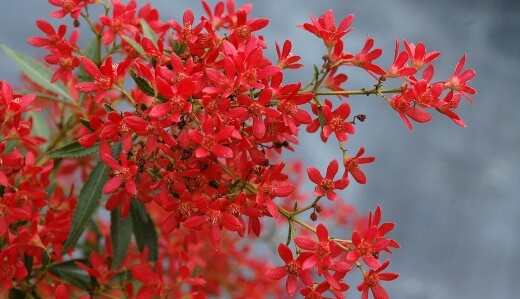
The NSW Christmas Bush is a curious plant with interesting and bright ‘flowers’ that appear throughout the summer. These flowers start with small white petals that, once pollinated and fruited, will dry out and make way for its Christmas decoration.
The flower sepals elongate and turn a rich pink to red giving a whole new display around Christmas time. Thriving in warm, moist and humid environments, these plants produce a double display from October through to Christmas.
Growing from a rounded shrub and maturing into a pyramid-shaped tree, plants normally grow two up to 6 metres in height.
Read our comprehensive guide on how to grow NSW Christmas bush for more insights.


Get Your Free Guide:
Master Growing Australian Natives eBook
A Must Have Complete Guide for Every Australian Garden
Get Your Free Guide:
Master Growing Australian Natives eBook
A Must Have Complete Guide for Every Australian Garden
3. Australian Honeysuckle (Banksia)
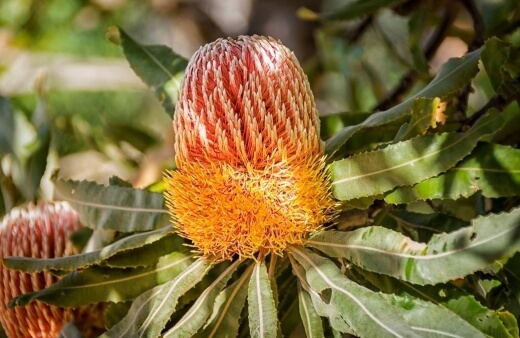
Banksias, or Australian Honeysuckle, is another incredible flowering plant with over 70 varieties. Part of the Proteaceae family, these versatile plants produce a range of cylindrical flower spikes, which range in colour from cream, yellow, and orange, to green.
Their flower spikes are nectar-rich and consist of hundreds to thousands of individual flowers often scented with a sweet honeysuckle-like fragrance.
Banksias thrive in local soils and can be grown in full sun and partial shade. Mostly grown as small to medium-sized shrubs, pick banksias as a feature plant, filler plant or ground cover to benefit local wildlife and pollinators.
Take a look at our list of growing guides to find the perfect Banksia to grow.
4. Bottlebrush (Callistemon)
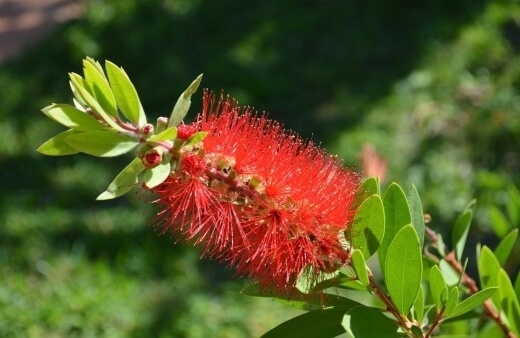
Bearing a similarity to banksias, callistemons or bottlebrushes are a popular summer bloomer guaranteed to bring an eye-catching element to your garden.
Commonly named ‘bottlebrush’, referring to its bottlebrush-shaped flowers, Callistemon includes a range of vibrant trees and shrubs with cylindrical flower spikes. These plants are incredibly hardy and are considered extremely low-maintenance.
Some varieties are adaptable, but bottlebrushes generally prefer a moist but free-draining soil but can tolerate salt-laden and boggy conditions.
Take a look at our Callistemon species and cultivar growing guides for everything you need to know about this incredible genus.
5. Eucalyptus

The beautiful blooms and foliage of the eucalyptus are a popular choice for a range of floral arrangements. Commonly known as messmate or stringybark, eucalyptus produces attractive flower clusters with long, vibrant stamens.
They are suited to container growing or in a sunny spot in your garden. Eucalyptus plants don’t need much to establish themselves, and once they are, they thrive without much effort making them a common choice for residential areas.
Check out these fantastic options.
6. Kangaroo Paw (Anigozanthos)
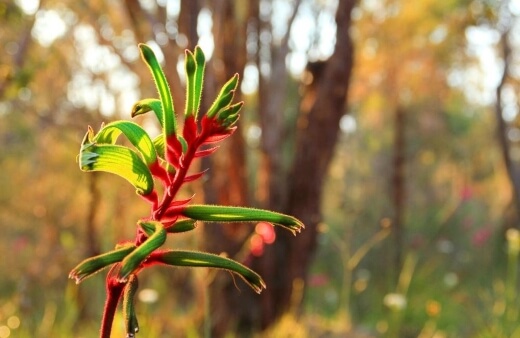
The floral emblem of Western Australia, Kangaroo Paw, or Anigozanthos, is quirky and exciting. Commonly named ‘kangaroo paw’ due to its fluffy-looking flowers as they emerge in the shape of a six-fingered paw.
With furry, tubular flowers, these plants are the perfect choice if you’re looking for an ornamental garden plant.
Kangaroo paws or sometimes called cat’s paws, thrive in full sun and acidic soil. They’re definitely an Australian native plant that offers high impact for very little maintenance.
Take a look at our Kangaroo Paw plant guide for more.
7. Common Lilly Pilly (Syzygium smithii)

The Syzygium smithii, or Common Lilly Pilly, was formerly known as Acmena smithii and is probably one of the most well-known Australian natives.
Known as the Australian Cherry, the Lilly Pilly is usually grown for its famed, edible fruit. However, the Lilly pilly also produces some remarkable blooms that resemble those of other myrtle family staminate flowers, with long stamens forming a little white pom-pom.
These evergreen, tropical plants are perfect for hedging and screening. However, it does have a slightly invasive root system, so it will need sufficient space to grow.
Follow our Lilly Pilly guide for everything you need to know.
8. Wattle (Acacia)
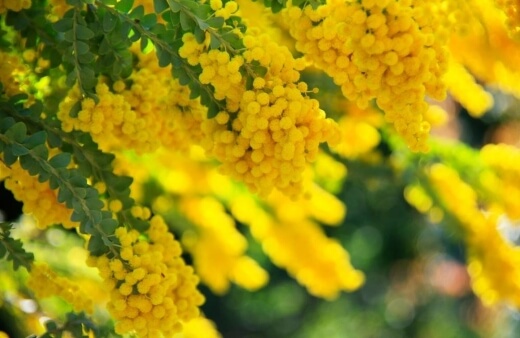
Acacias or wattles are incredibly common in Australian gardens. These larger shrubs and trees are accustomed to thriving in harsh conditions and produce spectacularly fragrant, bright golden blooms that display in late winter through to spring.
Golden Wattle is synonymous with Australia and is, in fact, our national flower, with a dedicated National Wattle Day on 1st September. Wattle has important significance in Australian history and has to be a prominent wildflower in any true native garden.
These plants grow incredibly fast and can be invasive so considered planting is important. Acacias begin flowering from a young age and they are very adaptable, and happy in both hot and cold conditions.
If you’re planning on growing acacias, take a look at our growing guides below:
9. Salmon Correa (Correa pulchella)
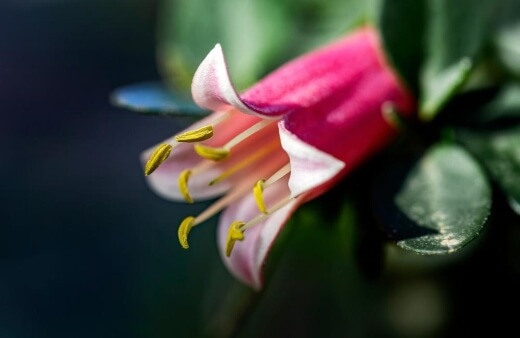
Native Fuchsia, or Correa pulchella, is a winter bloomer with wonderfully nectar-rich, salmon-coloured flowers. They are known as the Australian fuchsia thanks to their tubular pendant flowers with a reflexed trim, resembling the display of fuchsias.
They love warm, tropical and coastal climates and have a long flowering period from autumn through to spring the following year.
These plants enjoy moist, loam soils and can thrive in full sun and partial shade. Plus, once they’re established, they’ll require very little extra attention and will attract nectar-feeding birds to your garden.
Cultivar: Correa puchella ‘Dusky Bells’
10. Woolly Tea Tree (Leptospermum lanigerum)
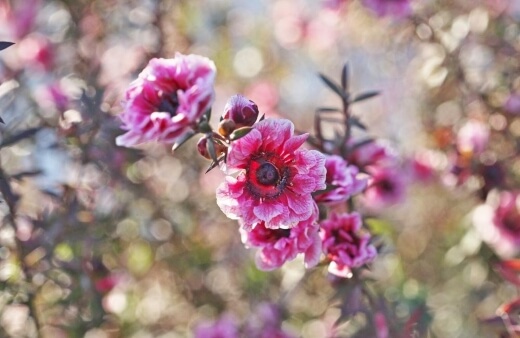
Leptospermum lanigerum, or woolly tea tree, is a tall-growing tree with fantastic white blooms and deep green leaves. It is commonly known as the woolly tea tree due to the fine and silky hairs covering its leaves, branches and fruit capsules.
Blooming throughout the summer season, the woolly tea tree can be found naturally across New South Wales, South Australia, Victoria and Tasmania.
They thrive in full sun and enjoy rich, moist soils. Once planted, your Leptospermum will almost care for itself, only needing occasional pruning to control shape.
Explore our guide for growing Leptospermum lanigerum for more information.
11. Sturt’s Desert Pea (Swainsona formosa)

More of a creeping vine, Sturt’s Desert Pea is an eye-catching and curious native flowering plant. Sturt’s Desert Pea or Swainsona formosa is an elongated vine that produces flower stalks with deep, vivid, red flowers and kidney-shaped seeds. It grows naturally in most of mainland Australia except for Victoria.
The desert pea’s weirdly wonderful flowers have adapted to being pollinated by birds and can be seen blooming from July to March.
Grow your Desert Pea as part of a rockery, in a hanging basket or in a tall-standing terra cotta pot. Although reportedly short-lived, grafted desert peas are known to be more successful.
Take a look at our Sturt’s Desert Pea guide for more details.
12. Hibiscus

Of all the Hibiscus species known, over 100 varieties are native to Australia. They can be found most often growing in vivid swathes across the East Coast. The most commonly grown are perennial and tropical hibiscus, which each have slightly different growth requirements.
These fantastic native flowers in Australia are the perfect way to add a touch of the tropics to your garden and home. They grow on tree and shrub forms and in a variety of colours so a perfect variety for your garden will be easy to find.
Read our full growing guide on Australian Native Hibuscus to learn more.
13. White Correa (Correa alba)
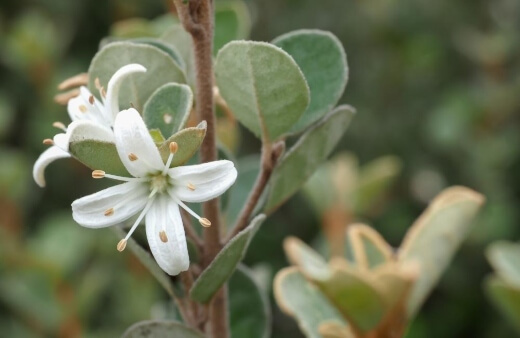
Another winter bloomer is the Correa alba. It has fantastic grey-green ovate leaves with woolly undersides and white star-shaped flowers, which are incredibly nectar-rich. Their stems are rust-coloured when young and also have a woolly, hairy coating.
They’re a great choice for warm, tropical environments as well as arid regions. Correa alba can grow in a range of soils and is suitable for both full sun and part shade.
Growing in a prostate manner typically to around 1.5m, perfect for an average size space.
14. Egg and Bacon Plant (Eutaxia obovata)
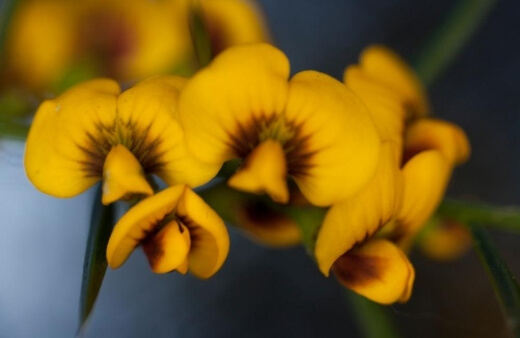
While the name may put you off if you’re not into breakfast foods, the egg and bacon plant, or Eutaxia obovata, is a gorgeous native flower with a gentle, delicate beauty. It has green foliage and a long flowering stem with bright yellow to orange sweet pea-shaped flowers.
Suited for full sun and partial shade, these shrub-forming plants need nothing more than well-draining soil, occasional watering and a prune when young to give shape.
15. Australian Daisy (Brachyscome)

Brachyscome, more commonly known as the Australian Daisy, is perfect if you’re looking for flowering ground cover. This highly adaptable plant produces a wealth of delicate mauve, white and blue flowers.
Brachyscome is definitely a must for anyone looking for a floriferous native garden. Grow yours in a sun-dappled spot with well-draining soil.
Discover more about Brachyscome and its popular varieties here.
16. Heart-leaf Flame Pea (Chorizema cordatum)
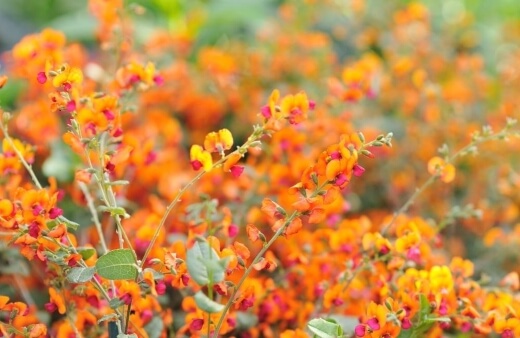
Another gorgeous evergreen plant, the flame pea or Chorizema cordatum, is a spectacular plant with orange and red pea-shaped flowers. Although they don’t love overly wet conditions, they love a good summer shower.
Typically found growing in dry sclerophyll woodland, shrubland and forest. This woody, climbing shrub is capable of scrambling up to 2 metres in height. This member of the pea family has typical pea flowers but in a striking orange-pink contrast.
17. Fan Flowers (Scaevola aemula)

Fairy fan flowers or common fan flower Scaevola aemula, is a popular shrub that’s perfectly suited to growing in pots outdoors. There are around 70 species of Scaevola with just over half being native to Australia.
They’re an incredibly attractive plant that produces unique fan-shaped flowers in blue, purple and white, looking almost like half a full flower.
This unusual shrub will provide a constant display of flowers throughout the warmer months with little pruning requirements. They do require full sun and well-draining soil but thrive in most environments.
18. Hakea
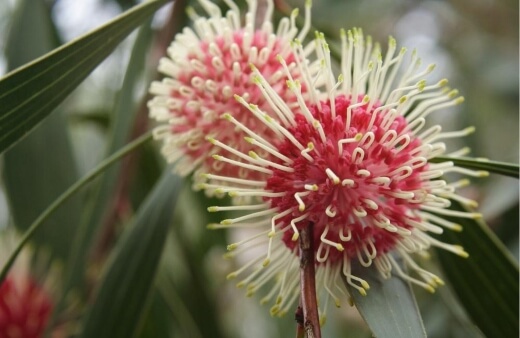
Hakeas are popular Australian natives that include a wide range of cultivars with surprisingly unique flowering habits. Nectar-rich bloomers, these plants will attract a range of nectar-feeding birds to your garden.
The needle bush has unique and eye-catching flowers. The flowers can range from white, ribbon-like petals to pink to red pom poms or bottlebrush-like cones with white tips. Some hakea have very pointed leaves giving them the name needle bush.
The Hakea ‘Burrendong Beauty’, Hakea myrtoides, and Hakea laurina are such varieties with intricate pin-cushion, pom-pom blooms. The Hakea bucculenta is an upright-growing variety with bottlebrush-like flowers.
19. Lemon Myrtle (Backhousia citriodora)

With its beautiful, typical myrtle flowers, Backhousia is a fantastic native shrub with many beneficial properties and benefits. This myrtle is endemic to the subtropical rainforests of southeastern and central Queensland.
Great for landscaping, the lemon myrtle is suited to a range of environments and has fantastically fragrant foliage.
Long used as a herbal remedy for indigenous people, its citral properties are often higher than lemongrass so it was even used in cooking. It benefits its neighbouring planting as it acts as a pest repellent with its strong, natural aroma.
Lemon myrtle needs rich soil with plenty of nutrients to grow. However, the effort will be well worth it.
Follow our Lemon Myrtle Australian growing and care guide for everything you need to know.
20. Trigger Grass (Stylidium graminifolium)
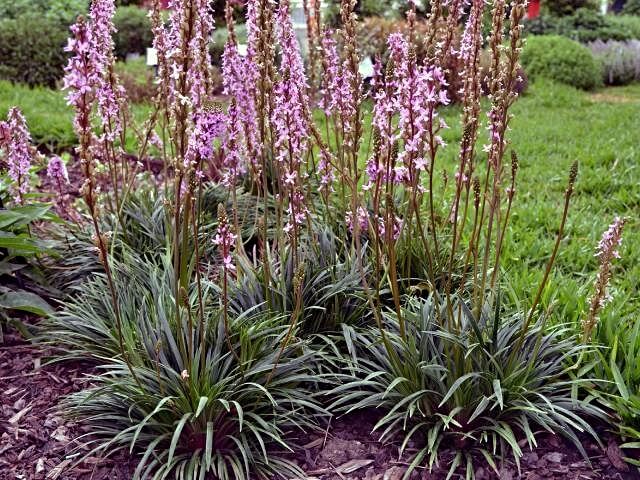
Source: Plants in a Box
Contrary to its name, trigger grass or little sapphire is, in fact, a flowering plant with deep blue foliage and pink flowers. A tuft-forming Australian native that will perform best when placed in a sunny location where it will provide tall flower spikes from August through to January.
Their common name comes from their unique pollen dispersal where they are triggered to deposit pollen onto the backs of pollinating bees. They are complex plants with around 130 different varieties. Found growing naturally in dry sclerophyll forests, widespread throughout Australia.
Trigger grass is also considered to be semi-carnivorous as it can trap and digest prey through glandular trichomes underneath the flowers.
21. Pink Rock Lily (Dendrobium kingianum)

The pink rock orchid is part of the orchid family with gorgeous flower spikes which often reach up to 25mm. It is one of the most sought-after native flowering plants and makes a fantastic ornamental specimen.
Endemic to eastern Australia, this typically pink flowering orchid is commonly cultivated by specialist Australian orchid breeders and is popular within native-focused horticulture.
Luckily, it’s not an incredibly fussy plant as its natural habitat can range from hostile cliff edges and forest creeks to the smallest rock crevices in open plains. This orchid blooms for a long time and is beneficial for attracting native pollinating insects.
22. Silver Spurflower (Plectranthus argentatus)
One of the rarest Australian native flowers, the silver spurflower belongs to the mint family with stunning, striking foliage and pale blue and white petals.
Covered with a fine layer of hair, the leaves of the silver spurflower look almost silver to grey, hence its common name. It is both fragrant and attractive, and suited to a range of local conditions.
Native to the bordering range of Queensland and New South Wales, the silver spurflower is found growing naturally in rocky outcrops of the rainforest. It will grow to around 1m in height and spread well, forming an attractive shrub.
23. Rice Flower (Pimelea)

Pimeleas include around 150 species of which 110 are native to Australia. They are a wonderful variety of uniquely blooming plants that range from pink to white to a combination of both. The flowers of this plant often grow in a round globe, which creates an eye-catching spectacle.
Commonly named rice flowers after their tiny flower buds that, en masse, resemble grains of rice. Rice flowers are perfect for growing in pots positioned in full sun, rockeries and borders. They are also particularly well suited to coastal conditions.
Don't miss our list of Pimelea growing guides here:
24. The Royal Bluebell (Wahlenbergia gloriosa)
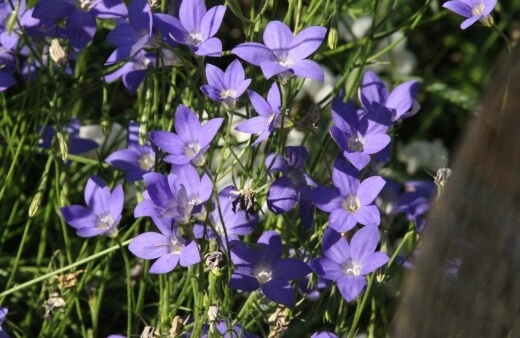
This alpine is a member of the Campanulacea family and grows naturally on rocky alpine sites, and on herbaceous alpine and grassland. If something striking is what you’re after, then you should definitely consider the Royal Bluebell or Wahlenbergia gloriosa.
The Royal Bluebell is an Australian native wildflower, perfect for ground cover, rock gardens and hanging baskets. Not only are its eye-catching deep blue-purple flowers a stunning addition to your native garden, but the petals are also edible and will brighten up a salad.
Take a look at our Royal Bluebell guide for everything you need to know about this incredible plant.
25. Boronias
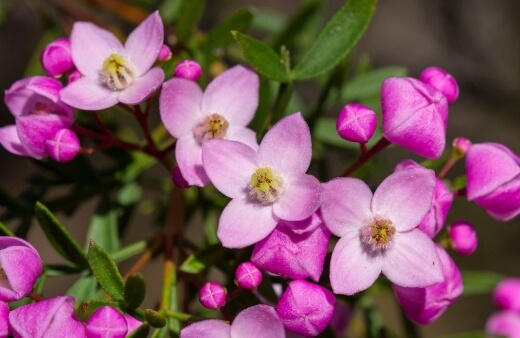
Boronias are popular Australian plants grown for their fragrance and bold flowering habit, with a range of cultivars blooming in every shade of pink. Although they are not known to be easy to grow, their charming presence in your garden will be worth it.
Found growing naturally in open forests and woodland, and occasionally found in rainforests and arid locations, they are generally widespread throughout Australia.
Boronia forms small to medium-sized shrubs that have very fragrant foliage when bruised or disturbed. Boronia foliage is said to have a pleasant scent, but some species are particularly strong and even unpleasant.
Boronia growing and care guide:
26. Swamp Bottlebrush (Beaufortia)
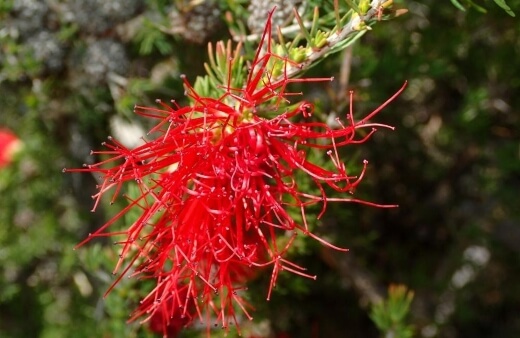
Beaufortias are best known for their interesting and unique flowers and evergreen foliage. They are commonly called the swamp bottlebrush due to their striking resemblance to the bottlebrush flowers of Callistemon.
This evergreen shrub grows to around 3 metres tall displaying bright orange to red flowers. Similar to many other bottlebrushes, they thrive in full sun and loose soils, but do best with high moisture.
Swamp bottlebrush naturally grows around seasonal wetlands or swamp areas, Beaufortia is distributed mostly in the southwest of Australia. This unique native would be a perfect candidate for a marginal pond plant or garden bog.
Growing guide: Beaufortia sparsa
27. Paperbarks (Melaleuca)

Another variety with bottlebrush-like blooms is the Melaleuca species, which is a popular choice for Australian gardens. Endemic to tropical regions across Northern and Eastern Australia, they’re a guaranteed statement piece.
With several common names, the broad-leaved paperbark is a small to medium tree in the myrtle family. Different species can be taller but mostly are around 1-3 metres in height and can be pruned into an attractive flowering hedge. They can also serve as a good wind break.
Explore our Melaleuca growing guides below:
28. Waratah (Telopea speciosissima)
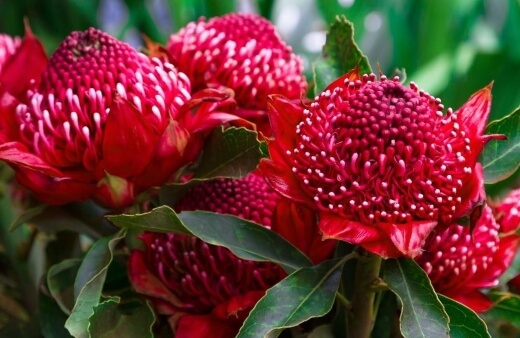
Arguably one of the most beautiful wildflowers Australia has to offer, the Waratah or Telopea speciosissima is Native to New South Wales and thrives in well-draining, richly composted soils. It prefers slightly shaded areas, as direct sunlight can cause petal damage.
Behind its large and showy flowers, Waratah is actually a collection of many small, densely formed flowers that form these big heads. They flower through September and October in Sydney but a little later in cooler areas.
Waratah makes ideal cut flowers and is widely cultivated for the cut flower market in Australia and overseas.
Refer to our in-depth guide on how to grow New South Wales Waratah for more details.
29. Red Flowering Gum (Corymbia ficifolia)

The red flowering gum or Corymbia ficifolia is a wonderful eucalyptus, and suitable for growing right across Australia. With breathtaking blooms, it’s ideal for large and small gardens alike, as it comes regularly grafted onto different rootstocks that control growth size.
This species contains a diverse range of cultivars ranging in colour from orange, white and pink to red.
Endemic to southwestern Australia, this small tree has rough and fibrous bark and typically grows to a height of around 10 metres. This tree forms a lignotuber so is adaptable and can survive harsh pruning and even bushfires.
Truly a showstopper tree, the red flowering gum is a marvel when in full flower. This flowering gum supports local wildlife and pollinators including nectar-feeding birds.
30. Spider Flowers (Grevillea)

Grevilleas are grown all over Australia and are prized for their profuse flowering that happens all year round. Also called spider flowers, grevilleas include over 350 different species of plants, which produce exciting spiked flowers ranging in colour from white, pink, orange, red and lilac.
They are named spider flowers after the inflorescence, which has an extremely long stigma leading to the reproductive parts of the flower. These can be long, curled and decorative, but are often referred to as the ‘spiders’ legs’ of the plant.
Depending on which variety you choose, they can be grown as ground cover, shrubs or taller screening plants. These plants love the sun and thrive in most local soils. Plus, they’ll attract plenty of local birds and butterflies.
Take a look at our list of gardeners' guides to grow grevilleas to find the perfect fit for you.
- Grevillea ‘Bronze Rambler’
- Grevillea ‘Coconut Ice’
- Grevillea ‘Dorothy Gordon
- Grevillea ‘Honey Gem’
- Grevillea ‘Ivanhoe’
- Grevillea ‘John Evans’
- Grevillea ‘Loopy Lou’
- Grevillea ‘Moonlight’
- Grevillea ‘Ned Kelly’
- Grevillea ‘Orange Marmalade’
- Grevillea ‘Peaches and Cream’
- Grevillea ‘Robyn Gordon’
- Grevillea ‘Royal Mantle’
- Grevillea ‘Seaspray’
- Grevillea ‘Superb’
31. Strawflowers (Xerochrysum bracteatum)
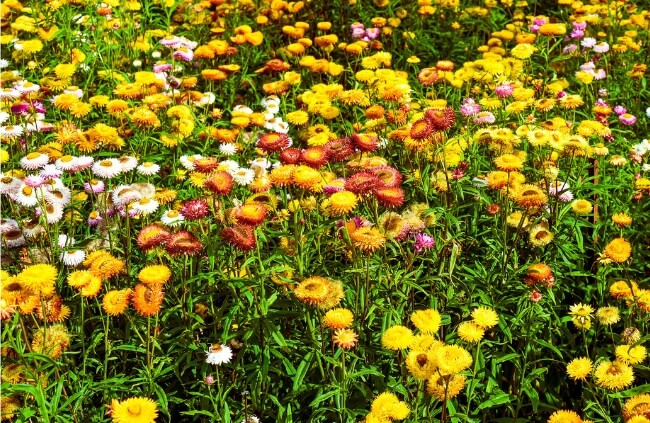
Flowering in a profusion of colour, strawflower has a floral display from late winter through to summer. This hardy perennial is very adaptable to a range of climates and for many, is a must when curating a wildflower border or seed mix.
Taller varieties are popular for mixed borders. They provide height and they’re excellent when dried in flower arrangements.
Paper daisies prefer a sunny position but can be grown in many different soil types. The native species of golden everlasting is widespread across Australia and can be found growing naturally in rainforest margins, sub-alpine areas and even desert plains.
32. Pink Billy Buttons (Gomphrena canescens)
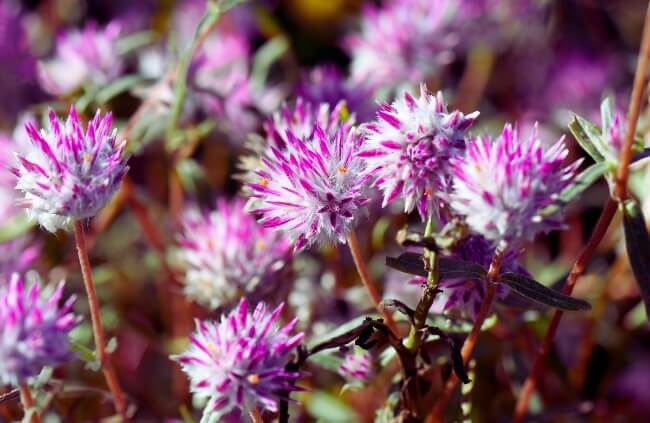
Pink Billy Buttons, also known as Bachelor buttons, are hard to say no to when looking for native wildflower inspiration. This is a different species to the yellow globular Billy Buttons you may be familiar with.
This native wildflower is found growing in tropical areas of Western Australia, and Queensland. It prefers moist soil in woodland and grassland but can easily tolerate very hot and humid summers.
Pink billy buttons will reward you with charming pink, white and sometimes purple flowers from spring through to late summer depending on climate.
33. Cottonheads (Conostylis candicans)

Source: Cottesloe Coastcare Association
Native to Western Australia, cottonheads are a cheerful, clumping perennial that form beautiful yellow and white flowers in abundance. The bright flowers occur from winter through to summer and are contrasted against the glaucous almost silvery, strip-like foliage.
Conostylis candicans is a tolerant and hardy wildflower that can withstand salty coastal conditions, extreme wind and poor soil. It can withstand moderate frosts and will cope well with drought but not waterlogged conditions as it has an underground rhizome.
Cottonheads are a brilliant addition to a native landscape, when planted in large numbers they can have the look of grassland or prairie.
34. Australian Flag Iris (Orthrosanthus multiflorus)
The Australian flag iris is found naturalising in southern states of Western Australia. It is considered to be a highly ornamental wildflower that forms clumps with receded strap leaves beneath protruding flower stems, tipped with sky-blue flowers.
Part of the appeal is in its mystique, as each flower lasts just one day, before fading to a tidy seedhead. It seeds well on sandy or free-draining soils, making it an ideal choice for any wildflower garden.
Read our comprehensive Iris growing guide for more varieties to choose from.
35. Fringe Lily (Thysanotus multiflorus)
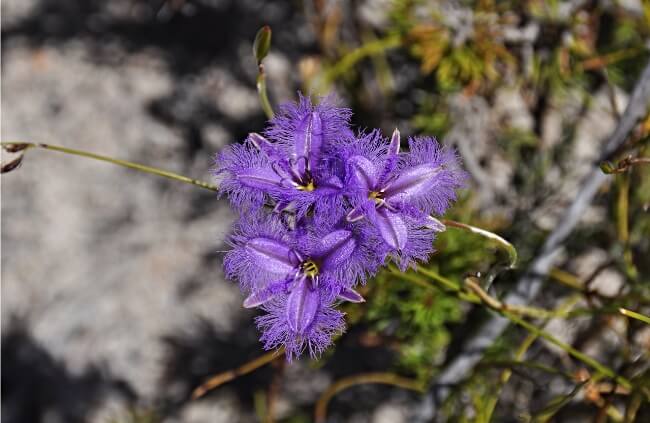
Fringe Lily is a popular native flower for gardeners in and around Victoria and NSW, where it spreads easily in its native range. The monoecious flowers are self-fertile so it offers an easy and low-maintenance plant for meadows.
The finely fringed purple flowers are incredibly decorative, but what lies beneath is a tough plant that grows well across most parts of the country.
36. Winged Everlasting (Ammobium alatum)
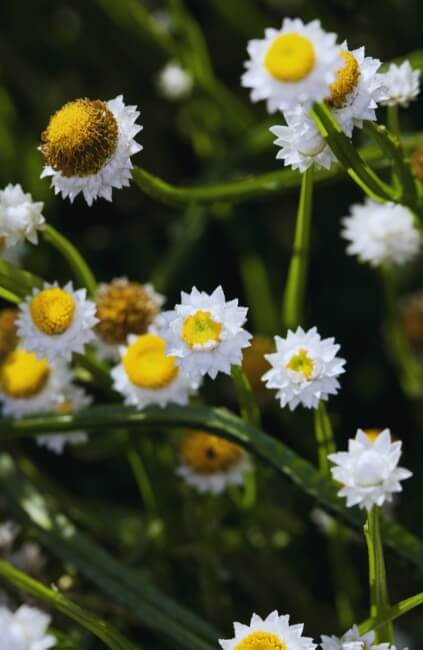
Winged Everlasting, or Everlasting Sandfower, is Australia’s answer to gypsophila. Each inflorescence combines a highly geometric mandala of white overlapping petals with a sturdy dome of yellow at its centre.
They are native to grasslands, and do best in mixed planting, but can look stunning in pots and containers too.
37. Pressed Hair Buttercup (Ranunculus pascuinus)

Source: iNaturalist Guatemala
Buttercups are adaptable plants. They will grow in rocky crevices, sand and bogs, but our native Ranunculus pascuinus is best suited to meadow planting and is by far our easiest wildflower to help establish an informal garden.
Simply sow the seeds, or plant plug plants directly into your lawn. It is one of only a few plants that can battle against tough grasses for nutrients and soil space and will help you to establish other annual and perennial wildflowers in the mix.
38. Dayflowers (Commelina)
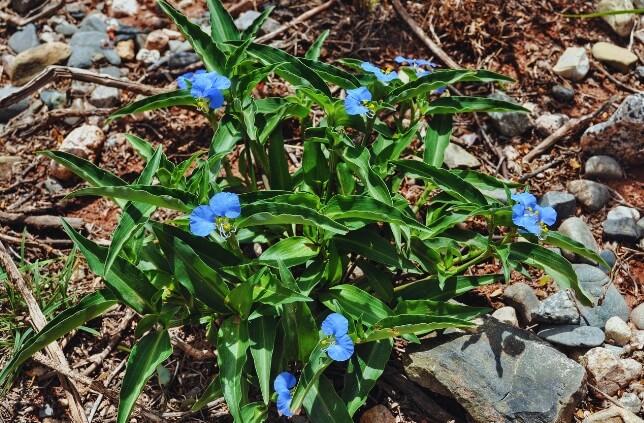
Dayflowers, like blue flag iris, have flowers that last just a single day. Each plant continues producing new flowers for several weeks each year, and the range of species means that there are Commelina varieties that can be grown in every single part of the country.
Sometimes called Widow’s Tears, these delicately petalled blue wildflowers have an eye-catching sculptural quality, with symmetrical wings, and twining anthers.
39. Byblis liniflora

Source: Ferri Seeds
Byblis might not look like it, but it is a member of the mint family (Lamiales). The most useful species for wildflower gardening is Byblis liniflora, which can tolerate a range of soil types, including damp loam, making it ideal for naturalising partially shaded spots with poor drainage.
Its delicate foliage fades into the background, so you are drawn to its subtle pink flowers, which poke through everything else when planted in mixed patches.
40. White Paper Daisy (Rhodanthe floribunda)
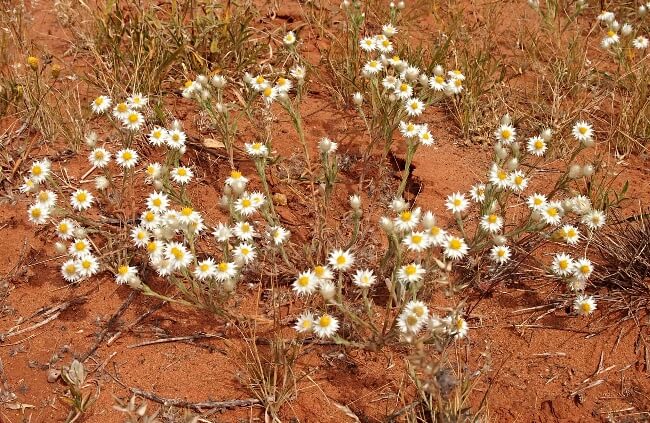
Source: Wikimedia
Until recently, the white paper daisy was known as Helipterum floribundum, but it was reclassified. Now called Rhodanthe floribunda, this neat, clump-forming daisy is Australia’s answer to Mexico’s Erigeron.
It will colonise in incredibly arid soils and spread well by seed, or division if you want to speed things along. In open spaces, it will form neat domes, but it comes to life in mixed, dry, grassland, where its flowers thrive and tower above light grassy foliage to create a spectacular wash of white.
41. Blue Rottnest Island Daisy (Trachymene coerulea)
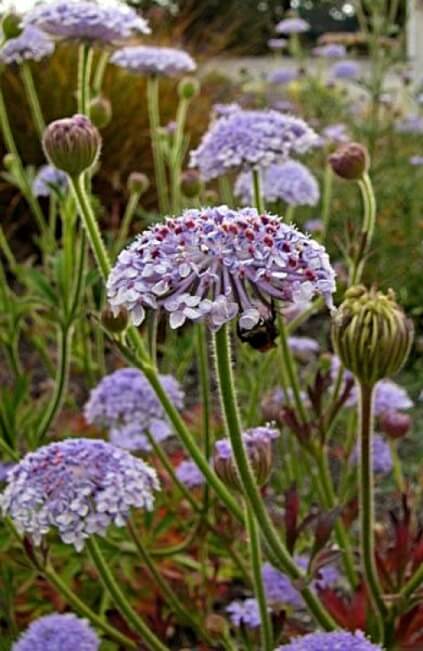
Source: Australian Seed
Blue Rottnest Island Daisy might be its common name but it is generally better known by its scientific name - Trachymene coerulea. This dramatic wildflower boasts a wonderful plate of blue flowers and grows to a bold 1m tall.
Each plant will reach 50cm across and grow well in warmer parts of the country as a reliable perennial with a shrubby habit.
42. Flannel Flower (Actinotus helianthi)
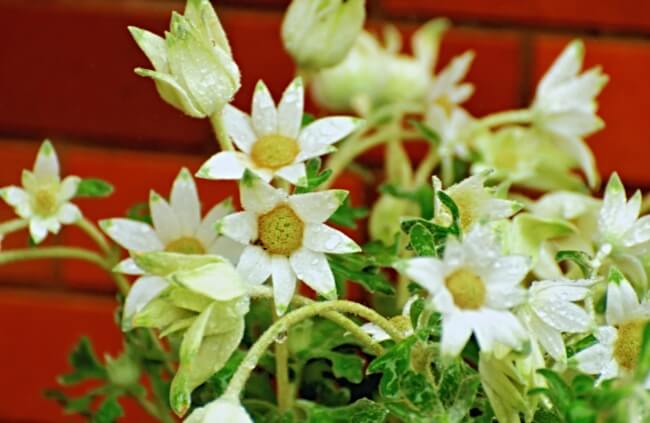
And last but by no means least, is the Flannel Flower. Australia’s native Actinotus helianthi is possibly a little too bold for some gardeners, with its pointed titanium-white petals and silver centre. But paired with other white native species, it adds texture in a completely unique way.
The petals have a powdery, felty, coasting, which captures sunlight and reflects it back softly. It’s a miracle of nature that never ceases to astound me and one that should be grown in every Australian garden, no matter the size.
Quick Trivia: Did you know that the Flannel flower is Australia’s symbol for mental health awareness? Find out more about this Australian native here.
Read our full Flannel flower growing guide for more information about this Australian native.
Australian Native Flowers Frequently Asked Questions
What is Australia’s most popular flower?
The Acacia genus consists of some of our most popular native species found all around Australia. The Golden Wattle variety is also our national flower.
What Australian natives flower in summer?
Very popular choices for summer flowering natives include banksias, bottlebrushes and kangaroo paws.
What flowers bloom all year in Australia?
Native violets sport beautiful purple and white blooms all year round.
What are the most popular native plants in Australia?
The five most popular Australian native plants are banksia, waratah, wattle, bottlebrush and eucalyptus.
What Australian native flower blooms in spring?
Pink heaths are very popular choices for spring flowering natives that will bloom throughout spring and continue into the winter.
What Australian flowers bloom in winter?
Banksias are excellent winter flowering blooms for gardens. Reliable winter flowering options include the hairpin banksia (B. spinulosa) and the heath-leaved banksia (B. ericifolia).
How long do Australian native flowers last?
Many natives produce blooms that can last up to 6 weeks without water and a lot longer with proper care. This is because they are very well adapted to our climates and conditions.
How often should you water Australian native plants and flowers?
As a general rule of thumb, many of our native trees and shrubs should be watered well about once every 2 to 3 weeks in summer and every 3 to 4 weeks in winter. This can vary depending on rainfall. Some natives may not even need much water once established.
For even more stunning native flower ideas, check out our YouTube video:
20 Mind-Blowing Australian Native Flowers You Won't Believe Exist:
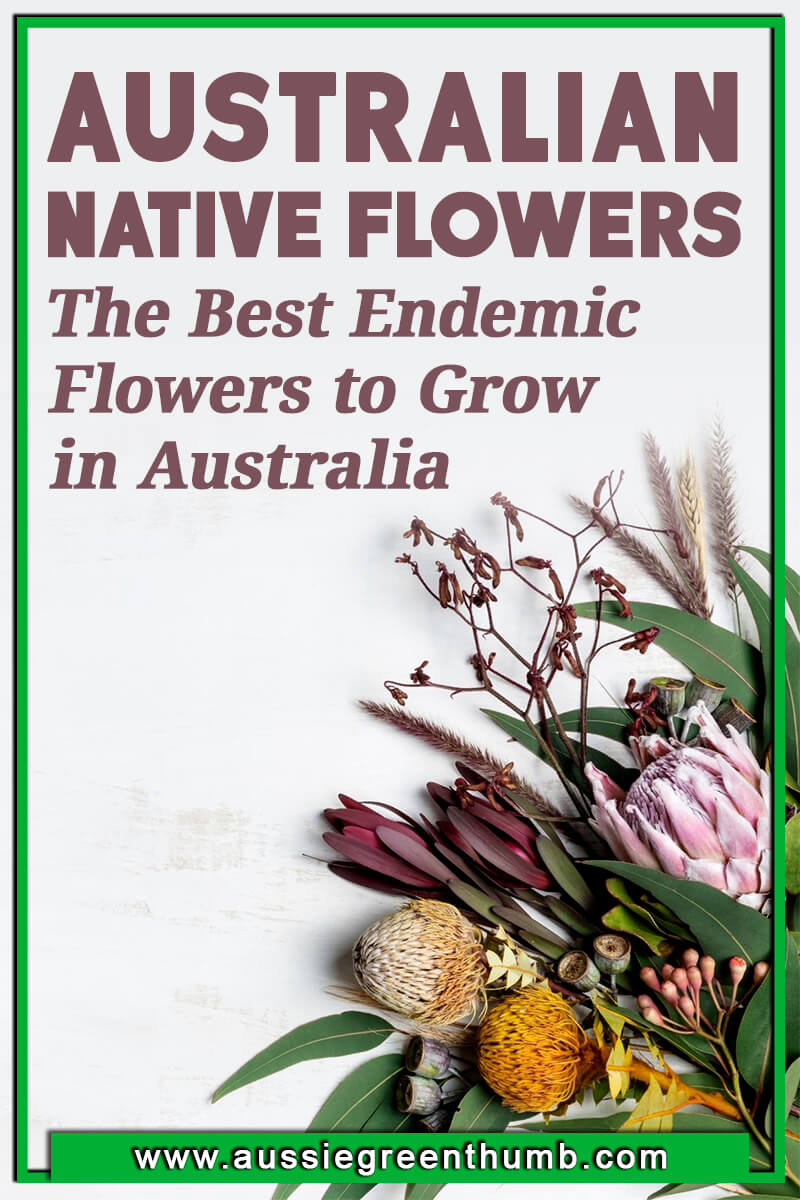
Start Growing Australian Native Flowers Today!
Planting native Australian flowers is simple, and you don’t have to limit yourself to meadow planting or annuals. Our beautiful country hosts some of the most diverse plant life on earth and we, as gardeners, should celebrate that with every chance we get.
Find out more about how to plant native Australian wildflowers in our planting guide, or let your creativity run wild with some of these outstanding native flowers that can often be found growing naturally within view of your front door.
Published on January 6, 2023 by Gary Clarke
Last Updated on October 1, 2025

